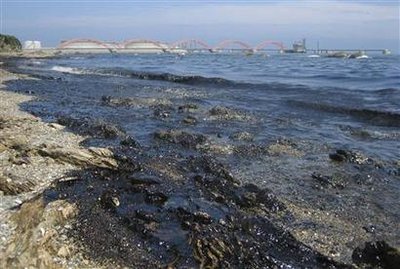
A view shows crude oil in the sea near Dalian, Liaoning province July 18, 2010.… Read more » REUTERS/China Daily
One of China’s biggest ports, Dalian, shut on Monday after an pipeline explosion triggered a major offshore oil spill, forcing a refinery to cut processing and importers to divert cargoes elsewhere.
The aftermath of the weekend fire could disrupt shipments of oil, iron ore and soy and add to pressure for stricter environmental standards in China, already reeling from a toxic copper mine leak in the south of the country which burst into headlines last week amid accusations of a cover up.
The fire began on Friday while a crude oil tanker was being off-loaded.
Nobody was hurt, but hundreds of firefighters battled for more than 15 hours to douse the fire, and state media said about 1,500 tonnes of oil had spilled into the sea, causing a 183 sq km (71 sq mile) slick, 50 sq km of which was “severe.”
Of the 50 sq km area, 20 sq km had been cleaned up and 160 tonnes of oil had been collected by 6 p.m. (1000 GMT) on Monday the local government said in a statement. The clean up operation may take five days, it said, without giving a timeframe for the port.
As many as six Very Large Crude Carriers (VLCCs), or 12 million barrels of crude oil, are set to be diverted, shipping sources said, possibly to South Korea or any one of another half dozen VLCC terminals in China.
Dalian’s Xingang oil port is home to a 19 million-barrel strategic petroleum reserve facility, one of China’s four state storage bases already in operation, as well as commercial storage run by CNPC and PetroChina that may be even bigger.
It is also a transfer spot for two major refineries, Dalian Petrochemical Corp and WEPEC, both operated by PetroChina with a combined processing capacity of 600,000 barrels per day (bpd).
PetroChina has set up a contingency plan to cope with one week’s closure of the main oil port that receives crude shipments regularly and is also an export hub for gasoline and diesel.
Industry sources are divided on how long the port will stay shut, with some estimating between seven and more than 10 days, but officials could not give a timeframe.
PetroChina has started trimming refinery operations at one of the plants, the 200,000-bpd WEPEC, by “several thousand tonnes” per day.
“The port was sealed right after the explosion. We have a one-week contingency plan, but are hoping that the oil spill can be cleaned up as soon as possible,” an oil executive said.
The incident drew the attention of top Chinese officials, including President Hu Jintao, Premier Wen Jiabao and security chief Zhou Yongkang, who all issued statements and instructions during the blaze. But port officials did not show up at a news conference on Monday morning, a city government official said.
Workers are using skimmers and dispersants to break up the oil slick and stop it spreading, the official China Daily said. The pollution is concentrated about 100 km (62 miles) offshore.
“By Sunday evening, about 7,000 meters of floating booms had been set up and at least 20 oil skimmers were working to clean the spill,” the newspaper quoted local officials as saying.
There are no residents within 3 km (1.8 miles) of the affected site, and little “marine farming,” the report added.
MARKET IMPACT EYED
While the main oil facilities at the port were not damaged, a Dalian-based shipping agent told Reuters that 80-90 percent of all the berths of Dalian port, which includes Xingang, were shut, including for iron ore and grain cargoes.
Dalian customs authority has handled about 10 percent of China’s soy imports so far this year, with $175 million worth arriving in May, the last month for which figures are available.
“We aren’t sure yet how much of the port is closed or for how long it will be closed but if it isn’t just confined to the Xingang area then the impact on soybean imports is going to be massive,” said Li Qin, an analyst Capital Futures in Beijing.
“If the port is closed the volumes are bound to drop. Imports were actually rising in June and there are a huge number of orders that can’t just be canceled or diverted to other ports.”
Other soy market participants played down the importance of the accident, saying many buyers were well supplied, and the port was already congested, so a few days more made no odds.
Dalian Port, whose shares fell 5 percent, said the accident had not caused any direct damage to the oil terminal’s main facilities, the impact being limited to ancillary facilities such as control systems, but it was still assessing the effect on its operations.
Analysts played down comparisons with BP Plc’s spill in the Gulf of Mexico and said PetroChina’s parent, China National Petroleum Corp, could easily cover the damage costs.
“It’s not going to be a major cost in the big scheme of things. It’s going to be in the tens of millions of dollars, not tens of billions of dollars,” said David Johnson at RBS, who estimated the cost at $50 million.
“The question is, who owns the oil in the tanker and whether the oil is insured. But some of them will have to pay the clean-up costs. The question is, who’s going to be liable? It’s like the BP story — whose fault is it?”
(Additional reporting by Wee Sui-Lee in HONG KONG, Ruby Lian in SHANGHAI and David Stanway in Beijing; Luke Pachymuthu, Florence Tan and Naveen Thukral in SINGAPORE; Editing by Ramthan Hussain)
